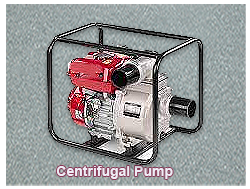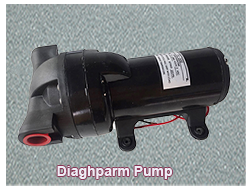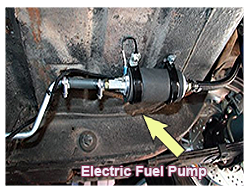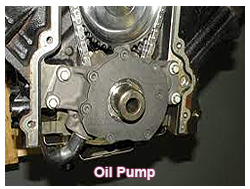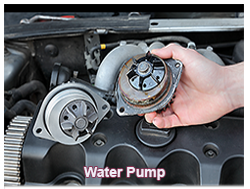
AUXILIARY ACCELERATION PUMP (AAP): Describes a type of pump capable of increasing driveability options during cold engine operation through injecting extra fuel to the acceleration nozzle supplementing the main acceleration pump.
CENTRIFUGAL PUMP:  Describes a pump that forces liquid from one location to another by the rotation of an impeller.
Describes a pump that forces liquid from one location to another by the rotation of an impeller.
CIRCULATING PUMP: Describes a centrifugal pump, such as an automotive water pump, which moves the liquid in a closed system.
DIAPHRAGM PUMP: Describes any device fitted with a flexible diaphragm that moves forward and backwards through a solenoid to transfer fluid.
ELECTRIC FUEL PUMP: Describes electrically powered gasoline or diesel pump which draws fuel from the tank and delivers it to the carburettor or fuel injection system
IN-LINE PUMP: Describes a pump whose suction and discharge branches are arranged in line for direct installation into the pipework.
INTERNAL GEAR PUMP: Describes a type of gear pump with a single rotor fitted with internally cut teeth that intertwine with an externally cut gear idler to prevent liquid from passing back to the suction side of the pump. Their quiet operation and high capacity characterise internal gear pumps.
INJECTION PUMP: Describes a type of pump that receives fuel from the fuel tank and delivers it under pressure to the injectors.
INJECTION PUMP GOVERNOR: Describes a device that controls fuel delivery to limit the minimum and maximum engine speeds and intermediate throttle positions.
JERK PUMP: Describes a pumping element found in an in-line injection pump.
LIQUID PUMP: Describes a machine used to raise liquid from low to high energy levels through the transfer of energy to the medium being pumped
LUBRICATION PUMP: Describes the pump used to apply lubrication oil to the specific points recommended by the manufacturer.
MULTI-STAGE PUMP: Describes a type of pump designed to operate against high pressures that can operate at two or more stages in a series, with several impellers built onto one shaft within the same casing.
MULTI-SUCTION PUMP: Describes a centrifugal pump with several impellers connected parallelly, separating the flow into two or more partial flows.
OIL PUMP: Describes the device, driven by a gear on the camshaft, located in the crankcase that pumps oil, under pressure, to various parts of the engine.
OIL PUMPING: Describes a situation in which an excessive quantity of oil passes the piston rings and is consumed in the combustion chamber.
POSITIVE DISPLACEMENT COMPRESSOR: Describes a category of pump designed to provide a measured amount of gas or liquid per stroke. Examples of positive displacement compressors include piston compressors, roots compressors and vane-type compressors
ROTOR PUMP: Describes an oil pump fitted with an internal rotor to drive an eccentric external gear.
TRANSFER PUMP: Describes an in-tank pump, used in some fuel injection systems, whose role is to boost fuel pressure levels slightly before the fuel is sucked into the main pump to prevent cavitation.
TWIN DIAPHRAGM PUMP: Describes a type of diaphragm pump fitted with two diaphragms; if one fails, the other comes in as a backup.
VACUUM BOOSTER: Describes a small diaphragm vacuum pump used to bolster engine vacuum during acceleration.
VACUUM CHAMBER: Describes a pneumatic actuator that converts air pressure differences into a regulating short-stroke movement.
VANE: Describes a thin plate attached to a rotatable unit used to throw off excess liquid that can also act as a pump.
VANE PUMP:  Describes a type of rotary pump fitted a rotor with hinged vanes that is typically used for air pumps in secondary air injection systems.
Describes a type of rotary pump fitted a rotor with hinged vanes that is typically used for air pumps in secondary air injection systems.
WATER PUMP: Describes a device that circulates the liquid through the cooling system by pumping it from the engine water jackets to the radiator.
PAR5
